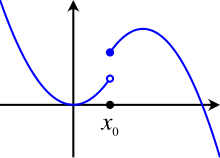In mathematical analysis, semicontinuity (or semi-continuity) is a property of extended real-valued functions that is weaker than continuity. An extended real-valued function is upper (respectively, lower) semicontinuous at a point if, roughly speaking, the function values for arguments near are not much higher (respectively, lower) than
A function is continuous if and only if it is both upper and lower semicontinuous. If we take a continuous function and increase its value at a certain point to for some , then the result is upper semicontinuous; if we decrease its value to then the result is lower semicontinuous.


The notion of upper and lower semicontinuous function was first introduced and studied by René Baire in his thesis in 1899.[1]
- ^ Verry, Matthieu. "Histoire des mathématiques - René Baire".





